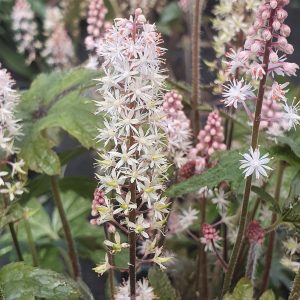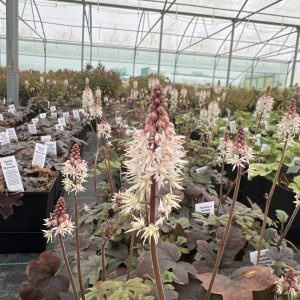Tiarella, also known as foamflower, is a delightful perennial known for its distinctive foliage and delicate flower spikes. Follow this planting guide to ensure the successful establishment and optimal growth of your Tiarella plants.
Choose the Right Location
Sun Exposure: Tiarella prefers partial to full shade. Choose a location with dappled sunlight or filtered shade for best results.
Soil Quality: Well-draining soil rich in organic matter is ideal. Tiarella plants thrive in humus-rich, slightly acidic to neutral soil.
Planting Time
Spring or Autumn: Plant Tiarella in the spring or autumn when the soil is workable. This allows the plant to establish roots before extreme weather conditions.
Spacing
Adequate Spacing: Space Tiarella plants 12 to 18 inches apart to allow for proper airflow and prevent overcrowding.
Planting Depth
Proper Depth: Plant Tiarella at the same depth as they were in the nursery containers. Ensure the crown is at or slightly above the soil level.
Watering
Consistent Moisture: Maintain consistently moist soil, especially during dry spells. Water deeply when the top inch of soil feels dry.
Mulching: Apply a layer of organic mulch around the base of the plants to retain soil moisture, suppress weeds, and regulate soil temperature.
Fertilisation
Light Fertilisation: Tiarella generally doesn’t require heavy fertilisation. Apply a balanced, slow-release fertiliser in spring as new growth emerges.
Deadheading
Regular Removal of Spent Blooms: Deadhead faded flowers regularly to encourage continuous blooming and maintain a neat appearance.
Pest and Disease Management
Vigilant Monitoring: Regularly check for pests such as aphids or slugs. Treat infestations promptly with insecticidal soap or appropriate measures.
Good Air Circulation: Ensure proper spacing between plants to promote good air circulation and minimise the risk of fungal diseases.
Pruning
Minimal Pruning: Tiarella generally requires minimal pruning. Remove dead or damaged foliage in late autumn or early spring to encourage new growth.
Division: Every few years, consider dividing clumps to rejuvenate the plant and control its size.
Winter Care
Mulching in Autumn: Apply a layer of mulch around the base of the plants in late autumn to protect against winter cold and temperature fluctuations.
Observation and Adjustments
Regular Inspection: Keep an eye on your Tiarella plants throughout the year. Adjust care practices based on observations of their health and performance.
By following this planting guide, you can establish and maintain healthy Tiarella plants that will provide a lovely display of foliage and blooms in your garden.





